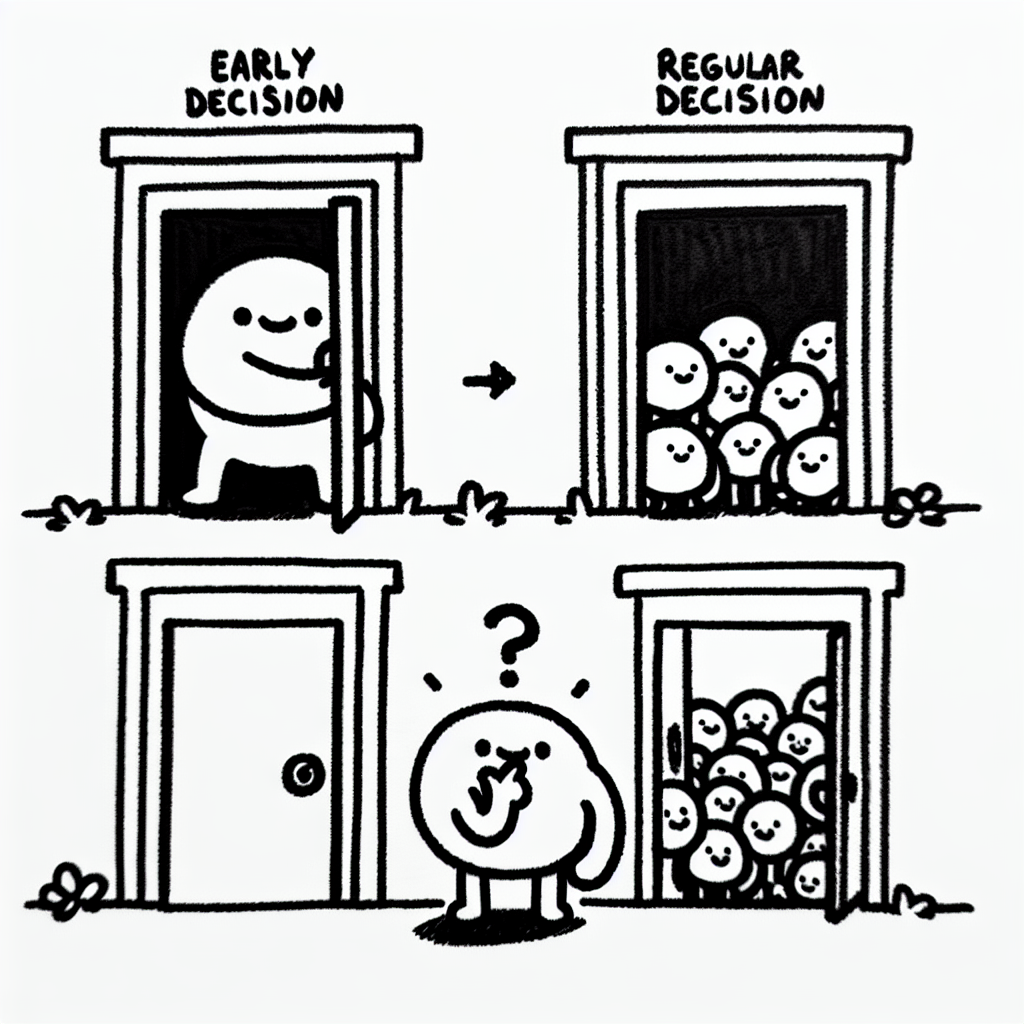Introduction
The college admissions process is becoming more complex each year, and for students applying in the 2025 cycle, understanding the differences between Early Decision (ED) and Regular Decision (RD) is crucial. With more schools offering binding ED options and evolving admissions trends, applicants face important choices that can impact their chances of acceptance and financial aid outcomes.
This guide examines Early Decision vs Regular Decision 2025, focusing on the key differences, benefits, and potential drawbacks of each application pathway. It also outlines the strategic considerations students should weigh when deciding which route best aligns with their academic goals and personal circumstances.

🔍 Overview: What Is Early Decision vs. Regular Decision?
When comparing early decision vs regular decision 2025, it’s important to understand how each application process works and what commitments are involved.
Early Decision (ED)
Early Decision is a binding admissions process. This means that if a student applies through ED and is accepted, they are required to attend that school and must withdraw all other college applications. Because of this commitment, students should only apply ED if they are certain that the college is their top choice.
ED applications typically have earlier deadlines, usually in early November. Applicants then receive their admissions decisions by mid-December, well before regular decision notifications are released. This can provide peace of mind for students who are admitted early, but it also means preparing application materials ahead of the standard schedule.
Regular Decision (RD)
Regular Decision is a non-binding process. Students who apply RD are not obligated to attend if they are accepted and are free to compare financial aid packages and offers from multiple schools before making a final decision.
RD applications usually have deadlines in January, giving students more time to complete their applications. Admissions decisions are generally released in March or April, allowing more time for schools to evaluate applicants and for students to make informed choices.
Understanding early decision vs regular decision 2025 helps students choose the path that best suits their college goals and preparedness.

📈 Higher Acceptance Rates: The Numbers Behind ED
Statistical Advantage for ED Applicants
When comparing early decision vs regular decision 2025, one of the most compelling factors is the significant difference in acceptance rates. For example, at Dartmouth College, the Early Decision acceptance rate for the Class of 2028 was 17%, while the overall acceptance rate stood at just 5.3% (US News). This stark contrast illustrates the statistical edge that Early Decision applicants often enjoy.
Why ED Applicants Are Admitted at Higher Rates
There are a few key reasons why early decision vs regular decision 2025 comparisons often show higher admit rates for ED applicants. First, submitting an ED application signals demonstrated interest—a clear indication that the student is committed to attending if accepted. Colleges often reward this level of interest with greater consideration.
Second, the Early Decision applicant pool is typically smaller and more self-selecting. These applicants tend to be well-prepared, academically strong, and have thoroughly researched the institution. As a result, admissions committees may find a higher proportion of qualified candidates among ED submissions, contributing to the elevated acceptance rates.

📊 Enrollment Trends: The Growing Role of Early Decision
Over the past decade, early decision has played an increasingly prominent role in college admissions, particularly at selective liberal arts colleges. In the 2012–13 academic year, just 44% of students at these institutions were admitted through early decision. By 2022–23, that figure had climbed to 55.5% (Wikipedia).
This trend is even more pronounced at certain colleges. Between 2015 and 2020, some institutions filled as much as 79% of their incoming classes through early decision (US News). Such reliance on early decision significantly impacts the regular decision cycle.
For students applying through regular decision in 2025, this means fewer available spots and potentially more competitive applicant pools. As colleges admit a larger share of their classes through early decision, the regular decision process becomes tighter, emphasizing the strategic importance of understanding early decision vs regular decision 2025.

Financial Aid and Affordability Considerations
Limitations in Comparing Aid Offers
One of the key differences in the early decision vs regular decision 2025 debate is how each pathway affects financial aid flexibility. Early decision (ED) is a binding commitment, meaning that students must accept an offer of admission without the opportunity to compare financial aid packages from other schools. This limitation can be problematic for students and families who need to evaluate multiple financial aid offers to determine the most affordable college option. According to US News, this lack of comparison is a significant reason some students may choose to avoid applying early.
The Case for RD for Financial Flexibility
Regular decision (RD), on the other hand, provides greater financial flexibility. Because RD decisions are not binding, students can compare financial aid offers from multiple colleges before making a final enrollment decision. This process enables families—especially those with substantial financial need—to assess which institution offers the best value and potentially negotiate for better aid packages. For students prioritizing affordability in the early decision vs regular decision 2025 choice, RD may be the more practical route.

⚖️ Equity and Access: Who Benefits from ED?
Disparities in Who Applies Early
The early decision vs regular decision 2025 landscape reveals stark disparities in who is able to take advantage of Early Decision (ED) policies. Students attending private high schools are over 3.5 times more likely to apply ED than their peers in public schools (US News). This gap stems, in part, from differences in access to experienced college counselors and institutional support. Many private schools have dedicated staff who guide students through the early admissions process, while public school students may face limited advising resources.
Impacts on Low-Income and First-Gen Students
ED can unintentionally widen gaps in college access. The binding nature of ED means students must commit to a school before comparing financial aid offers, which can be a major deterrent for low-income and first-generation college applicants. These students often cannot afford to take the financial risk associated with an early, binding commitment. As a result, many choose to apply through regular decision, where they can weigh financial aid packages across schools. In the early decision vs regular decision 2025 context, this may further concentrate opportunity among students from more privileged backgrounds.

🧠 Strategic Considerations for Applicants
When navigating early decision vs regular decision 2025, students should assess their individual circumstances to determine the most strategic application approach.
When ED Makes Sense
Early Decision (ED) can be a smart choice for applicants who are confident in their top-choice college. If a student has thoroughly researched a school and determined it to be the best fit academically, socially, and culturally, ED may increase their chance of admission. This route is especially advantageous for students with strong academic and extracurricular records by the start of senior year, as applications are typically due in November.
Another key factor is financial readiness. Because ED is binding, families must be certain they can afford the institution without needing to compare financial aid packages. Those who are financially prepared and have a standout profile early on may benefit from the higher acceptance rates often associated with ED rounds.
When to Opt for RD
Regular Decision (RD) offers more flexibility for students who are still evaluating their options. If academic performance is trending upward, students can use first-semester senior grades to strengthen their application. This is especially relevant for those who had a slower start in high school but are demonstrating strong recent improvement.
RD is also preferred when financial considerations play a central role. Applying through RD allows students to compare financial aid offers from multiple institutions, giving families more leverage and choice in the final decision.
Alternatives: Early Action (EA)
Early Action (EA) provides a middle ground in the early decision vs regular decision 2025 conversation. EA allows students to apply early—typically by November—while retaining the freedom to choose among multiple offers. It is non-binding, meaning that students are not committed to attend if accepted.
EA is available at many private and public universities and can be a good fit for students who are prepared early but want to keep their options open. It offers the benefit of early feedback from colleges without the pressure of a binding commitment.

🔄 The Future of ED and RD: What to Expect in 2025 and Beyond
Continued Growth in Early Applicants
As the debate around early decision vs regular decision 2025 intensifies, the trend of increasing early applicants shows no signs of slowing. Students continue to perceive early decision (ED) as a strategic advantage, offering a higher acceptance rate at many selective institutions. This perceived edge motivates more applicants to commit early despite the binding nature of ED.
In response, colleges are increasingly adapting their enrollment strategies to favor ED applicants. By securing a significant portion of their incoming class through ED, institutions can better manage yield rates and class composition. This shift may further incentivize students to apply early, fueling the cycle of ED growth in 2025 and beyond.
Calls for Reform
However, the continued expansion of ED is not without controversy. Critics argue that early decision disproportionately benefits affluent students who can commit to a school without comparing financial aid offers. As the early decision vs regular decision 2025 landscape evolves, these equity concerns are prompting calls for reform.
Advocates for change suggest that colleges increase transparency around financial aid for ED applicants or reconsider the binding nature of ED altogether. Some policymakers and educational organizations are also examining whether ED policies align with broader goals of access and inclusion. As these discussions gain momentum, institutions may face pressure to adjust their early admissions practices to promote greater fairness and accessibility.

Final Thoughts: Making the Right Choice
When weighing early decision vs regular decision 2025, it's important to recognize that the right path varies by individual. There is no universal answer. Students should take an honest look at their academic readiness, financial situation, and personal goals before choosing a route.
Early Decision (ED) can provide a significant admissions advantage at some institutions. However, this option should only be pursued by students who are fully informed, confident in their top-choice school, and ready to commit—since ED is binding.
Regular Decision (RD), on the other hand, offers greater flexibility. It allows students more time to strengthen their applications, compare offers, and make well-informed choices—particularly valuable for those who need to assess financial aid packages.
Ultimately, choosing between early decision vs regular decision 2025 should align with each student's unique circumstances and comfort level with commitment and timing.

📚 Sources and Further Reading
To better understand the differences and implications of early decision vs regular decision 2025, the following resources offer detailed insights:
- US News: What to Know About Early Action and Early Decision: This article outlines key facts and strategies for students considering early application options.
- Wikipedia: Early Decision: A comprehensive overview of the early decision process, including its history and how it compares to regular decision.
- US News: Reasons to Skip Applying Early: Discusses why early decision vs regular decision 2025 may not be the right choice for every student.
- US News: Editorial Roundup on College Admissions: Offers a collection of editorials reflecting diverse opinions on the college admissions process.














